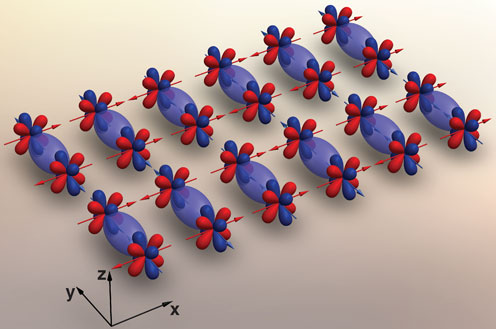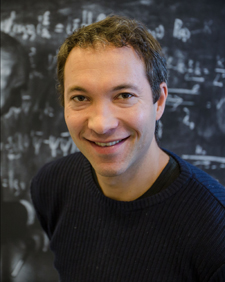What causes superconductivity? It will take legwork!
With a grant of 5,662,844 DKK from the Danish Council for Independent Research, Brian Møller Andersen, associate professor in condensed matter physics at the Niels Bohr Institute at the University of Copenhagen, will have the opportunity to try to understand the superconducting properties of iron-based superconductors. Superconductivity is a phenomenon with enormous application potential, but there is still a ways to go before it is explained. As so often before, the legwork will be done by the researchers

In iron-based superconductors, the superconducting electrons originate from the d-shell of the Fe atoms. There are five of those. The most important orbitals are the so-called xz and yz orbitals displayed by the red and blue clovers in the figure. The spin of the electrons are shown by the arrows, which play an important role in the origin of superconductivity, according to the researchers. In the superconducting state, electrons pair up and form a kind of “electron-molecule” which is the foundation for the superconducting state. In the new iron-based high-temperatur superconductors this pair-formation takes place between the yz electrons, shown by the light-blue ellipsoids in the figure. It remains a mystery why it is only these electrons that are most important for the superconductivity.
Brian Møller Andersen’s research group works with theoretical condensed matter physics and more specifically, researches the electronic properties of different materials. The project for which the grant was awarded concentrates on the magnetic and superconducting properties of materials. In some materials, the electrons interact strongly with one another and one of the challenges is that we do not yet have a good, unifying explanation of the phenomenon. “We lack a controlled theory that can quantitatively explain when superconductivity or magnetism occurs. The two phenomena should be “foes”, but in some systems magnetism must exist for superconductivity to occur – and vice versa,” says Brian Møller Andersen.
A lot of experiments have already been done, so there is data to work with, but we are still missing a unifying explanation of the phenomenon. “Our task will be to create realistic models of interacting electron systems that have superconducting order,” explains Brian Møller Andersen.
The magnetic fluctuations or lattice motion
An electron has a charge and a “spin”. The spin of an electron can connect to the spin of another electron. Thus, spin waves can be created through the system of electrons. The same applies to the atomic lattice in which the electrons are located. The atoms can also move and can thus actually give rise to superconductivity through their lattice fluctuations. The latter is the mechanism of ordinary superconducting metals. But in this project the researchers are pursuing the magnetic fluctuations in the spin of the electrons as a possible mechanism for superconductivity in new materials. It is known that certain new materials have nothing to do with the “ordinary” superconducting effect, so it is a new field that Brian Møller Andersen’s research group is moving into.
Basic research with great potential

Brian Møller Andersen, associate professor in the research group, Condensed Matter Theory has received a grant of 5,662,844 DKK. Foto: Ola Jakup Joensen
In order to make a robust quantum computer, i.e. a quantum computer where information does not dissipate or disappear very quickly, part of the exercise is to create what are called Majorana fermions – which only exist in systems with superconductivity. Therefore, superconductivity as a phenomenon is important in the construction of a quantum computer. Several research sections at the Niels Bohr institute also collaborate across these related topics. But it is not the quantum computer setting the agenda in this project, Brian Møller Andersen emphasises. “Our task is to understand superconductivity as a phenomenon. There are, of course, a myriad of applications for superconductivity at the end of the day, but it is basic research that determines our day-to-day,” he says.
High-temperature superconductivity and multi-orbital systems
High-temperature superconductivity, which is another element of the project is not in itself a new field. Something new in the grant from the Danish Council for Independent Research is the goal of making a realistic model for multi-orbital systems. For an electron is not just an electron. Electrons can be in different orbital states and thus have different spatial extents. If you come out in a d-shell, there are, for example, five different electrons that have a different spatial extent. “The multi-orbital effect seems to be a new effect for the materials we are studying, namely the iron-based superconductors. We are quite convinced that there will be exciting new interactions that could create new forms of superconductivity when we get the opportunity to dive deeper into the material. That is the goal of this project,” explains Brian Møller Andersen.
The project offers the opportunity to hire a postdoc for three years, as well as a PhD student. It also includes a very important guest programme, where top researcher Peter J. Hirschfeld from the University of Florida has already been invited to work with the condensed matter physics section for six months here in Copenhagen.

Brian Møller Andersen, Associate Professor in the Condensed Matter Theory research group at X-Ray and Neutron Science, Niels Bohr Institute, University of Copenhagen, Email: bma@nbi.ku.dk, Telephone: +45 3532-0419
Topics
See also:
Contact
Brian Møller Andersen, Associate Professor in the Condensed Matter Theory research group at X-Ray and Neutron Science, Niels Bohr Institute, University of Copenhagen, Email: bma@nbi.ku.dk, Telephone: +45 3532-0419
Brian M. Andersen: Superconductors
